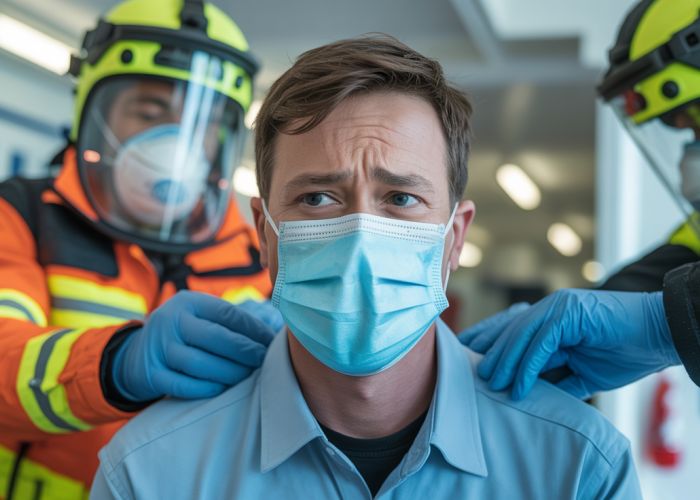Experiencing or witnessing potential polyurethane poisoning can be incredibly alarming. Time is of the essence, and understanding immediate actions is crucial. The local emergency services represent a critical first point of contact in such situations, offering immediate guidance and dispatching necessary medical assistance. Activated charcoal administration, often under the direction of Poison Control Centers, stands as a frequently recommended initial intervention, helping to limit toxin absorption. The specific polyurethane poisoning treatment protocols advocated by medical toxicologists offer valuable information and contribute to the best possible outcome.

Polyurethane Poisoning: Immediate Action & Treatment Guide
If you suspect someone has been exposed to polyurethane and is exhibiting symptoms of poisoning, immediate action is crucial. This guide outlines steps you can take and explains the "polyurethane poisoning treatment" process. Your priority should always be to ensure the safety and well-being of the affected individual.
Recognizing Polyurethane Poisoning
It’s important to first identify potential exposure and subsequent symptoms. Polyurethane itself isn’t inherently poisonous in its cured, solid form. Problems arise during its production or when it’s heated or burned, releasing harmful chemicals.
Exposure Sources
- Isocyanates: These are highly reactive chemicals used in polyurethane manufacturing. Exposure primarily occurs via inhalation or skin contact during production.
- Combustion Products: Burning polyurethane releases toxic fumes, including carbon monoxide, nitrogen oxides, and hydrogen cyanide.
- Spray-Applied Polyurethane: Improper ventilation during application can lead to inhalation of harmful aerosols.
Common Symptoms
Symptoms vary depending on the route and level of exposure.
- Inhalation:
- Coughing
- Shortness of breath
- Wheezing
- Chest tightness
- Sore throat
- Headache
- Nausea
- Skin Contact:
- Redness
- Itching
- Burning sensation
- Rash
- Eye Contact:
- Tearing
- Redness
- Blurred vision
- Pain
- Ingestion (Rare):
- Nausea
- Vomiting
- Abdominal pain
Immediate First Aid Measures
The following steps should be taken immediately if you suspect polyurethane poisoning. These are designed to minimize exposure and stabilize the individual while awaiting professional medical help.
- Ensure Safety: Remove the affected person from the source of exposure. If it’s fumes, get them to fresh air immediately. If it’s skin contact, proceed to step 2.
- Skin Decontamination: Wash the affected area thoroughly with soap and water for at least 15 minutes. Remove any contaminated clothing.
- Eye Irrigation: If the eyes are affected, flush them continuously with clean water for at least 20 minutes. Ensure the water flows from the inner corner of the eye outwards.
- Seek Medical Attention: Contact emergency services (e.g., 911) or your local poison control center immediately. Do not delay seeking professional help. Provide them with as much information as possible about the suspected exposure, including the type of polyurethane product involved (if known) and the symptoms being experienced.
Polyurethane Poisoning Treatment: A Medical Perspective
"Polyurethane poisoning treatment" is primarily supportive and focuses on alleviating symptoms and preventing further complications. There is no specific antidote for isocyanate poisoning. The medical team will assess the patient’s condition and administer appropriate treatment based on the severity of the symptoms.
Hospital Treatment
The hospital treatment plan may include:
- Oxygen Therapy: Administered to address breathing difficulties and ensure adequate oxygen saturation.
- Bronchodilators: Inhaled medications (e.g., albuterol) to open up the airways and ease breathing.
- Corticosteroids: Medications (e.g., prednisone) to reduce inflammation in the airways.
- Mechanical Ventilation: In severe cases of respiratory distress, a ventilator may be required to assist breathing.
- Skin and Eye Treatment: Topical creams and ointments may be used to soothe irritated skin and eyes.
- Monitoring: Continuous monitoring of vital signs (heart rate, blood pressure, breathing) is essential.
- Supportive Care: Intravenous fluids may be administered to maintain hydration. Medications may be given to control nausea, vomiting, or pain.
Long-Term Considerations
Depending on the severity of the exposure, some individuals may experience long-term health effects, such as:
- Reactive Airways Dysfunction Syndrome (RADS): A persistent form of asthma triggered by exposure to irritants like isocyanates.
- Skin Sensitization: Increased sensitivity to polyurethane or related chemicals.
- Chronic Respiratory Problems: Long-term cough, shortness of breath, or wheezing.
Regular follow-up with a healthcare professional is crucial to manage any long-term health problems.
FAQs About Polyurethane Poisoning
Here are some frequently asked questions about polyurethane poisoning, including important steps to take and what to expect during treatment.
What are the early symptoms of polyurethane poisoning?
Early symptoms can vary depending on the type of exposure (inhalation, ingestion, or skin contact). Common signs include coughing, shortness of breath, skin irritation, nausea, vomiting, and dizziness. Seek immediate medical attention if you suspect polyurethane poisoning, even if symptoms seem mild initially.
What’s the first thing I should do if someone inhales polyurethane fumes?
Immediately move the person to fresh air. If they are having difficulty breathing, administer oxygen if available and call emergency services. This is a critical first step in polyurethane poisoning treatment and can significantly improve their outcome.
How is polyurethane poisoning treatment administered in a hospital?
Hospital treatment typically involves supportive care, such as oxygen therapy for respiratory issues and intravenous fluids for dehydration. Doctors may also administer medications to manage specific symptoms like bronchospasm or skin irritation. The focus is on stabilizing the patient and preventing further complications.
Is long-term recovery possible after polyurethane poisoning?
The long-term prognosis depends on the severity and duration of exposure, as well as the promptness and effectiveness of polyurethane poisoning treatment. While some individuals fully recover, others may experience lasting respiratory or neurological issues. Follow-up care and monitoring are often necessary.
Hopefully, you now have a clearer picture of how to respond to polyurethane poisoning. Remember, acting quickly and knowing the basics of polyurethane poisoning treatment can truly make a difference! Stay safe out there.